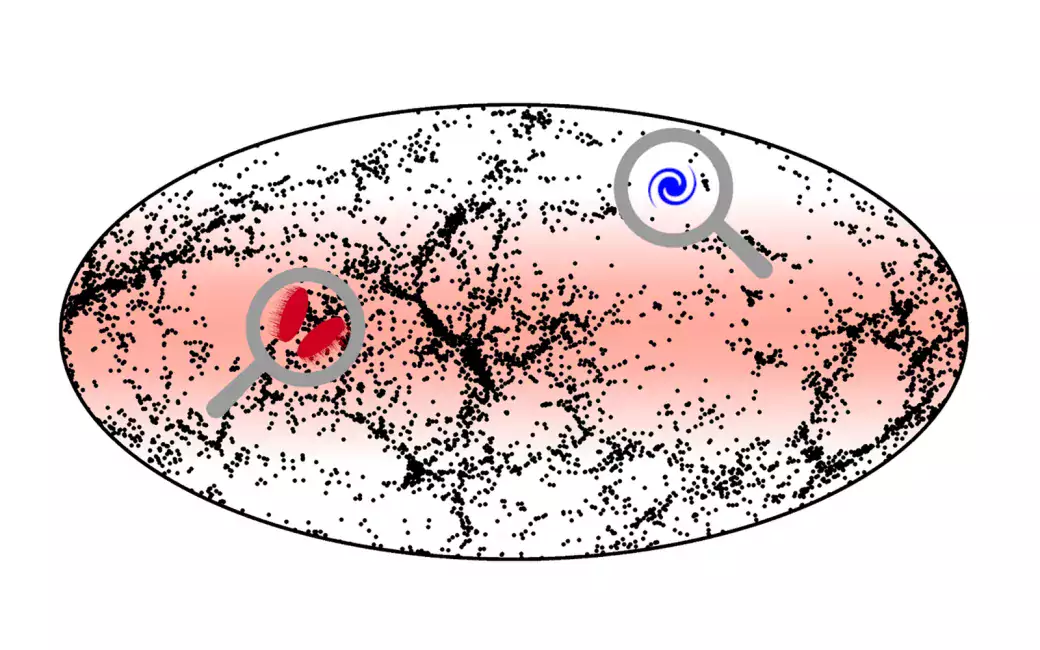Why is the vast supergalactic plane teeming with only one type of galaxies? This old cosmic puzzle may now have been solved.

Our own Milky Way galaxy is part of a much larger formation, the local Supercluster structure, which contains several massive galaxy clusters and thousands of individual galaxies. Due to its pancake-like shape, which measures almost a billion light years across, it is also referred to as the Supergalactic Plane.
Most galaxies in the universe fall into one of two categories: Firstly, elliptical galaxies, made mostly of old stars and containing typically extremely massive central black holes, and secondly actively star-forming disk galaxies, with a spiral-like structure similar to the Milky Way's. Both types of galaxies are also found in the Local Supercluster, but while the Supergalactic Plane is teeming with bright ellipticals, bright disk galaxies are conspicuously absent.
A cosmic anomaly challenges the standard model of cosmology
This peculiar segregation of galaxies in the Local Universe, which has been known since the 1960s, features prominently in a recent list of "cosmic anomalies" compiled by renowned cosmologist and 2019 Nobel laureate Jim Peebles.
Now an international team led by University of Helsinki astrophysicists Till Sawala and Peter Johansson appear to have found an explanation. In an article published in Nature Astronomy, they show how the different distributions of elliptical and disk galaxies arise naturally due to the different environments found inside and outside of the Supergalactic Plane.
"In the dense galaxy clusters that are found on the Supergalactic Plane, galaxies experience frequent interactions and mergers, which leads to the formation of ellipticals and the growth of supermassive black holes. By contrast, away from the plane, galaxies can evolve in relative isolation, which helps them preserve their spiral structure", says Till Sawala.
In their work, the team made use of the SIBELIUS (Simulations Beyond The Local Universe) simulation, that follows the evolution of the universe over 13.8 billion years, from the early universe to the present. It was run on supercomputers in England and on CSC's Mahti supercomputer in Finland.
While most similar simulations consider random patches of the universe which cannot be directly compared to observations, the SIBELIUS simulation aims to precisely reproduce the observed structures, including the Local Supercluster. The final simulation result is remarkably consistent with the observations.
"By chance, I was invited to a symposium in honour of Jim Peebles last December, where he presented the problem in his lecture. And I realised that we had already completed a simulation that might contain the answer", comments Till Sawala. "Our research shows that the known mechanisms of galaxy evolution also work in this unique cosmic environment".
Next to the physics department, the University of Helsinki's Kumpula campus hosts a large statue showing the distribution of galaxies in the Local Supercluster. It was inaugurated 20 years ago by the British cosmologist Carlos Frenk, who is one of the co-authors of this new study. "The distribution of galaxies in the Local Supercluster is indeed remarkable", says Frenk of the new results.
"But it is not an anomaly: our result shows that our standard model of dark matter can produce the most remarkable structures in the universe".
Original publication
Till Sawala, Carlos Frenk, Jens Jasche, Peter H. Johansson, Guilhem Lavaux, Distinct distributions of elliptical and disk galaxies across the Local Supercluster as a ΛCDM prediction, Nature Astronomy, 20 Nov 2023.






